Your Planets
Portraits of the Planets
Aspects between Planets
The planetary ages
The planetary families
Planets in Signs
The Planets in comics


The nature of astrological effects is primarily conjectural, stochastic and chaotic. There is therefore no mechanical astrological determinism of which a statistical study could show, and not demonstrate, the probability or the improbability. This fact has not stopped supporters and opponents of astrology from indulging in it for better (rarely) and worse (almost always). However, serious statistical studies could highlight and detect some of the most salient and therefore most visible astrological effects. But these have never been made, although all the elements are in place for them to be made. For daring researchers, a vast unknown territory therefore remains to be explored, knowing that it would be limited to the tip of the astrological iceberg, of which around 90%, by spinning this icy metaphor, would therefore remain beyond the reach of any statistics…
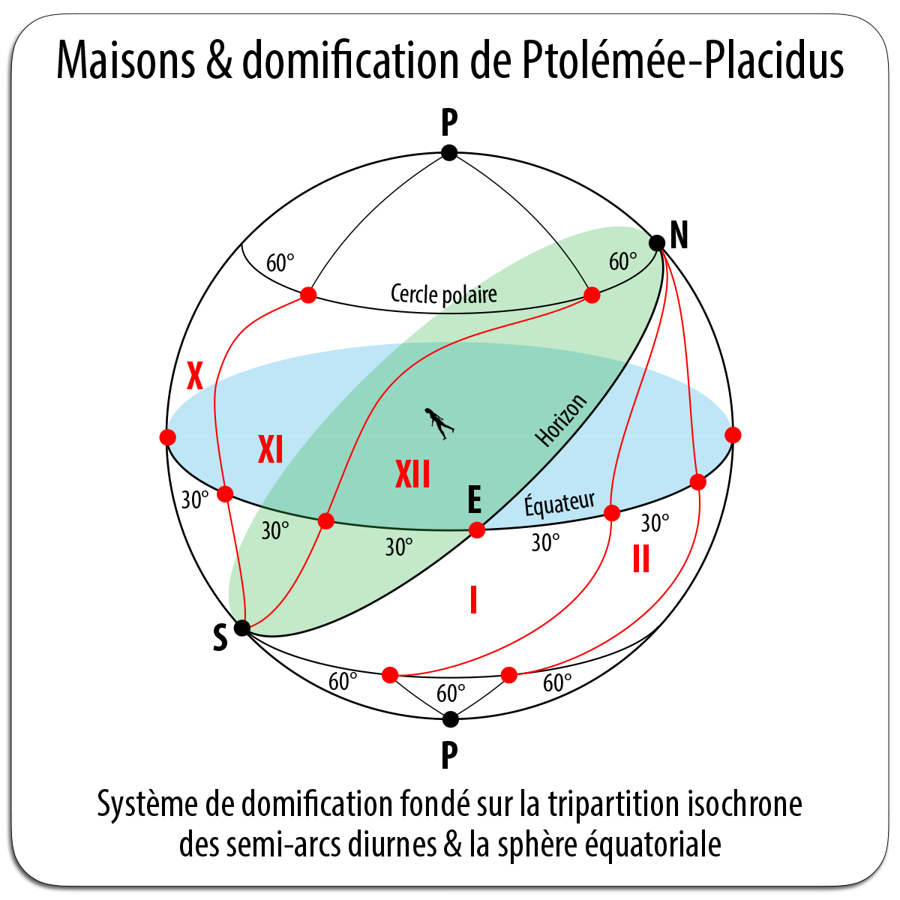
“If the base is solid, the house is solid” (Yi King).
“When fraud has built a house, it destroys it” (Malinké proverb).
“The sage has no home, no kinship, no country” (Philo of Alexandria, philosopher).
Since the advent of computers, which allowed the creation of astronomical calculation software for use by astrologers, it also goes without saying that you can opt for the house system that we desire. One can thus instantly choose between the calculation system of the Houses of Placide, Porphyry, Dodecatropos, Regiomontanus, Firmicus Maternus, Rhetorius, Alcabitius, Albategnius, Abenragel, Campanus or Koch and still others. We do not have to worry about whether the system on which we have clicked is based on ecliptic, horizontal, equatorial, or meridian bases, or even on a spatial or temporal reference, when a sky map appears immediately screen following this choice. We do not wonder if some are more relevant than others to represent the real zodiac-planetary movements in two dimensions on a computer, tablet or smartphone screen. We choose and we consume the Ascendant degree and the tip of the House without always knowing what it is, on what astronomical realities all this is based.
It is very fast, very practical and even very useful. Yet none of this is self-evident. The different systems proposed were imagined during the previous centuries by different astrologers with very varied astronomical skills. Some had only very rudimentary ones, those of the most learned were very elaborate, but none of these systems were invented or discovered in a click. All were the fruit of questioning and trial and error. Some are perfectly inept and incapable of correctly describing astronomical reality; others come as close as possible, such as the one improperly attributed to Placidus when it was drawn up by Ptolemy. The Ptolemeo-Placid system is fortunately the most commonly used since it is the one chosen by default by most astrological software. And most of the same software does not give any information on the astronomical relevance of the various systems, whereas this should be a decisive element in the choice of one system rather than another. As a result, all appear equal in quality in the drop-down menu where they appear. Which is completely false.
The choice of one system rather than another having a direct influence on the interpretation that will be made of the Chart thus obtained, the result is that, whatever the relevance and quality of the interpretation modules offered by certain software, the latter may be partially or completely false if you clicked on the wrong system. Indeed, the determination of the zodiaco-planetary dominants of a Chart is partly dependent on the chosen house system. Moreover, even if this system is the most relevant — in this case that of Ptolemy-Placidus — it is still necessary that the software does not content itself with taking into account only the ecliptic longitudes to calculate the planetary positions in the Houses. It is also imperative that it integrates the ecliptic latitudes of the planets so that these positions are as consistent as possible with astronomical reality. However, there are very few software offering this type of calculation, and the option for calculating ecliptic latitudes is never installed by default. It is up to the user, most often ignorant of astronomical matters, to include it in the calculations by clicking on an option. Suffice to say that this option is almost never selected, even though it is an essential parameter for knowing the real planetary positions in the Houses.
It is thus seen that the delimitations of the Houses, independently of the real or imaginary meanings which are attributed to these sectors of the local sphere, play an important role in the interpretation of a birth sky. And it is moreover by studying the frequencies of distribution of the Planets in these sectors, without worrying about the meanings of these, let us repeat it, that astro-statistics has made it possible to highlight key sectors determining planetary dominants.
The problem of the history of the astrological Houses therefore deserves to be better known and deepened. We will not discuss here that of the relevance of the different systems (this is not the subject), but that of the conception of these sectors, which differs very significantly according to the times and the hegemony exercised by this or that learned astrologer.
In what is known as the “tradition” astrological, and which essentially refers to the conversion and adaptation of Sumero-Chaldean astrology to Hellenistic conceptions from the 4th century BC, the 12 sectors of the local sphere or Houses are numbered in the senestrogyrate direction (counterclockwise). The senestrogyrate direction is that of the annual movement of the planets around the Sun. This numbering is counter-intuitive in terms of representation, in that it is opposed to the dextrogyrate direction (clockwise direction) which is that of the daily rotation of the stars on the ecliptic around the horizon.
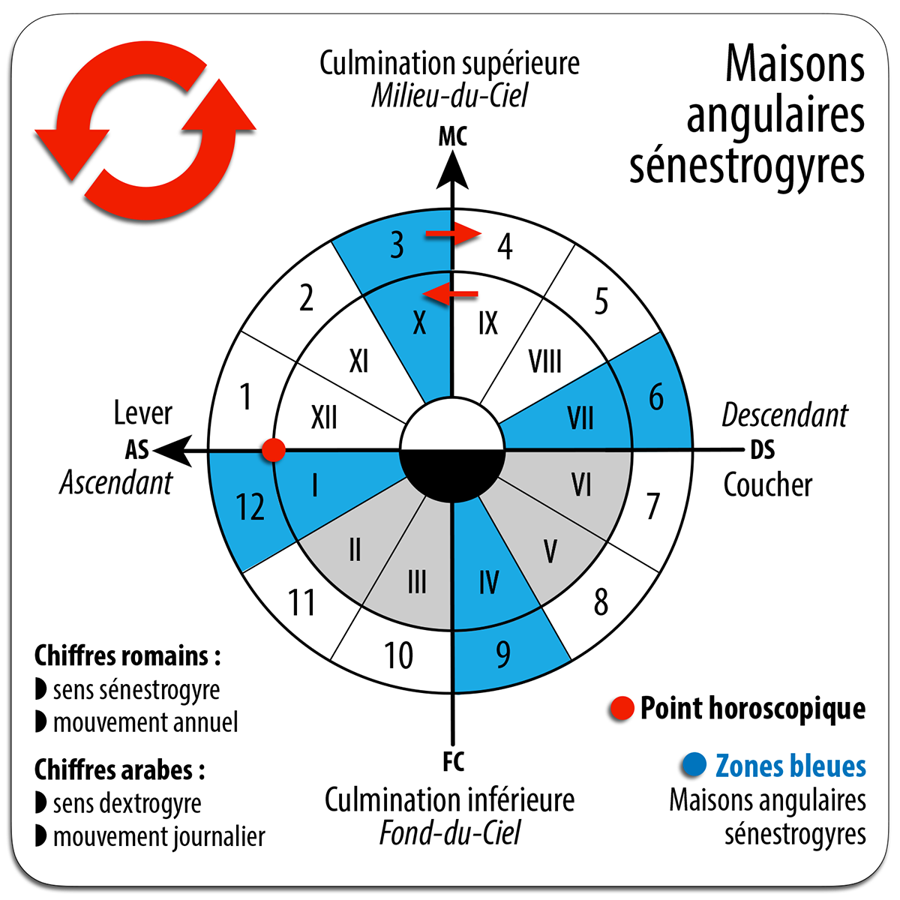
We can even rightly estimate that this senestrogyrate numbering “traditional” is nonsense. It would indeed be much more rational and consistent with the apparent reality of the local sphere to proceed to a dextrogyrate numbering of the Houses. We would thus assign Houses I, II & III to the ascending eastern quadrant (1st diurnal semi-arc from the ascending point to the upper meridian), Houses IV, V & VI in the descending western quadrant (2nd diurnal semi-arc from the upper meridian to the descending point), Houses VII, VIII & IX in the ascending western quadrant (1st nocturnal semi-arc from the descending point to the lower meridian) and finally Houses X, XI & XII in the descending eastern quadrant (2nd nocturnal semi-arc from the lower meridian to the ascending point). You should know that before this late Greek senestrogyrate addition, this was how astrologers counted the sectors of the local sphere (quadrants or Houses).
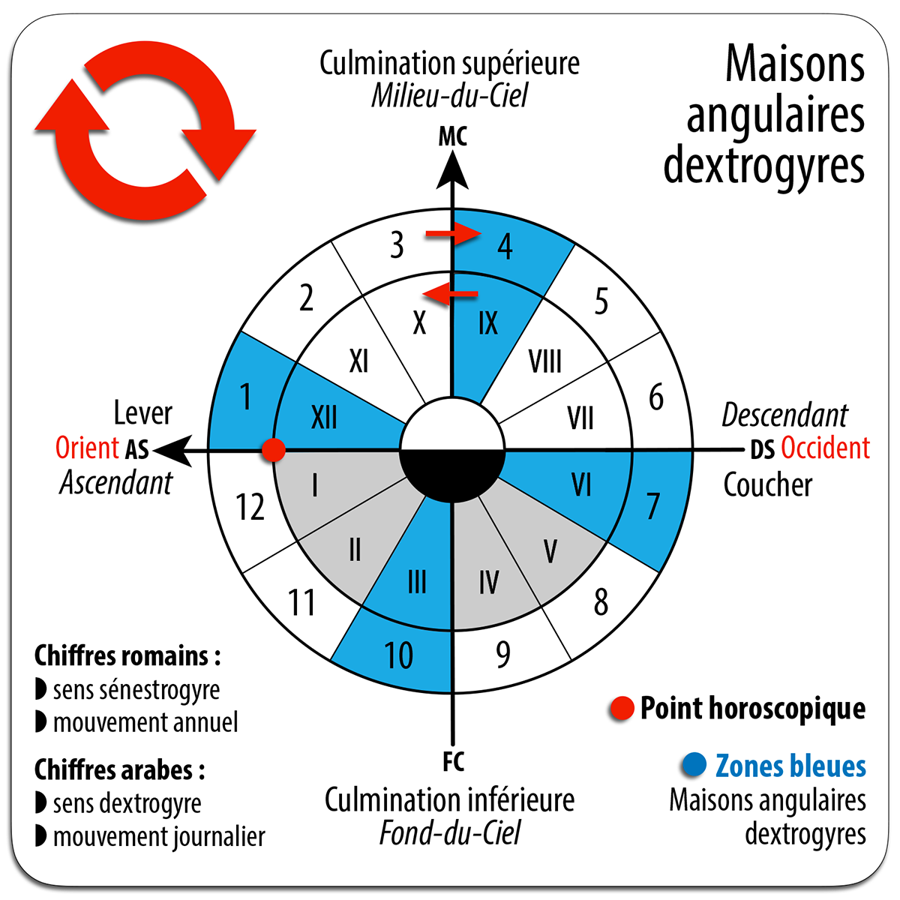
The resemblance of these ancient dextrogyrate angular houses with the “key sectors” of the Gauquelin statistics carried out with births before 1960 is absolutely striking:
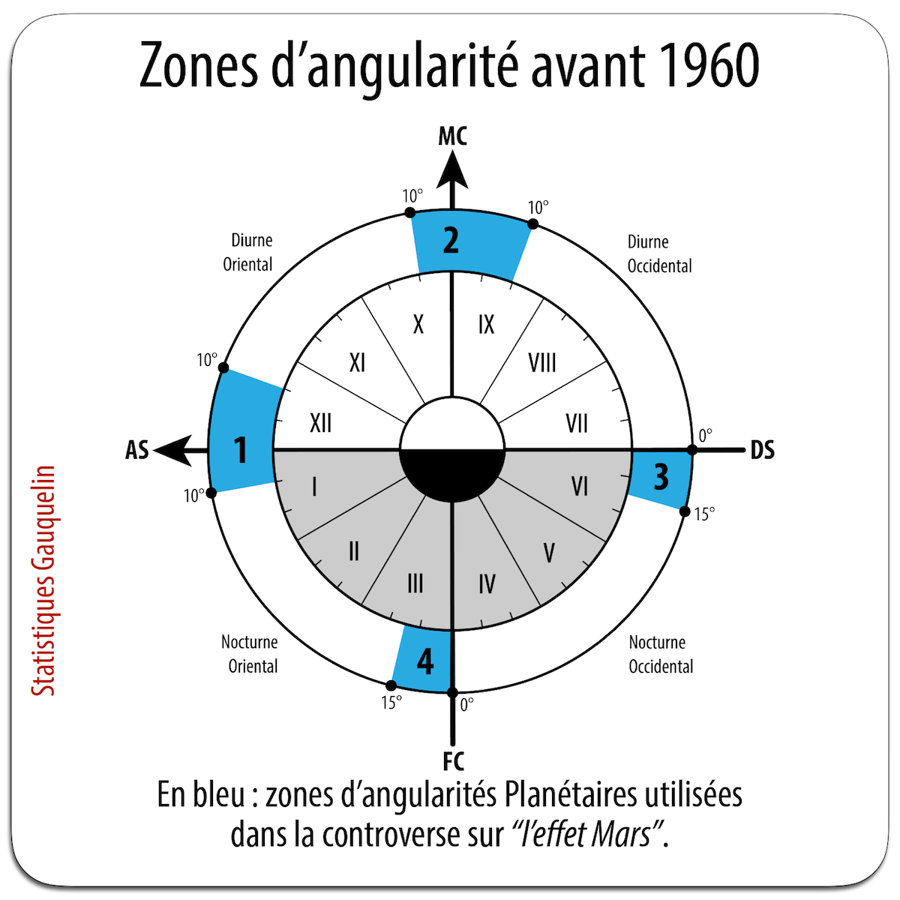
Some (Léon Lasson or Françoise Gauquelin in particular) claim a distant Sumero-Babylonian tradition to historically legitimize this dextrogyrate numbering. They are wrong: Chaldean or Sumerian astrology had no local sphere division system comparable to the House system. In any case, the star charts of this period make no mention of it. Indeed, the Babylonian astrologers had a dynamic and temporal vision of the circum-horizontal planetary movements. Their planetary astronomy of position referred only to the times of ascent of the Planets on the ecliptic from their rising, which made it possible to deduce when they would culminate at the upper meridian. And it is from these Chaldean calculations of times of ascension that the Greeks later imagined various systems of domification, which themselves gave birth to the 12 Houses to which were later attributed Meanings, all things which were foreign to the conception of the local sphere of the Babylonians.
One can wonder about the reason that prompted the Greeks to adopt the senestrogyrate numbering system at an indeterminate time. It is indeed of no practical use in terms of astronomical calculations. Its only result was to sow confusion between the annual senestrogyrate planetary rotations in the celestial sphere (whose center is that of the Earth) and daily dextrogyrate planetary rotations in the local sphere (whose center is the eye of the observer). This remains a mystery, since no document from the time allows us to know what mental process led to this absurd result. One can nevertheless have a confused glimpse of it on reading chapter IX of L’Astrologie grecque of Auguste Bouché-Leclerc, historian specializing in Greco-Roman antiquity and declared anti-astrologer.
The determination of planetary valuation zones according to the horizontal and meridian axes in the local sphere is a central problem which has always preoccupied the learned astronomers-astrologers of antiquity. The meridian plane posed no problem, which was not the case with the horizontal plane. Indeed, the exact culmination of a Planet at the upper meridian (MC, Midheaven) is a phenomenon that can be defined without ambiguity. It is then at the highest of its daily diurnal course, while a Planet at the lower meridian (IC, Imum Coeli) is at its lowest under the horizon in its nocturnal course. This non-ambiguity of the diurnal or nocturnal character of a meridian Planet is the reason why Ptolemy considers, in his Tetrabiblos, that the most influential planets are near the upper meridian, since the daytime effects (above the horizon) outweigh the nighttime effects (below the horizon).
The only problem which arose — and still arises — from an astrological point of view was to define the extent or duration of the two zones situated on either side of the meridian, zones within which the Planets are considered particularly influential, knowing that this influence diminishes or disappears when they are located before or after these two zones.
Determining the extent and duration of the horizontal zones surrounding the rising (Ascendant) and the setting (Descendant) poses a more complex problem. It has a primary and direct relationship with the determination of the horoscopic point. From a purely astronomical point of view, this designates the precise place of intersection between the plane of the ecliptic and that of the Eastern horizon, called the rising point or Ascendant point. It had indeed been observed that the Planets at their rising had a significant effect at the time of a birth.
The question then was — and still remains — to determine as precisely as possible the extent and duration of this “ascending zone” and its opposite on the western horizon, the “descending zone”. Indeed, these two zones consist of a diurnal part corresponding to Houses XII and VII (ascending and descending zones above the horizon), and of a night part corresponding to Houses I and VI (ascending and descending zones below the horizon). A precision is essential: here the Houses are only considered as the astronomical result of the division of the local sphere into 12 sectors based on the tripartition of the diurnal and nocturnal arcs. The astrological meanings granted to these sectors have no importance in the demonstration that follows.
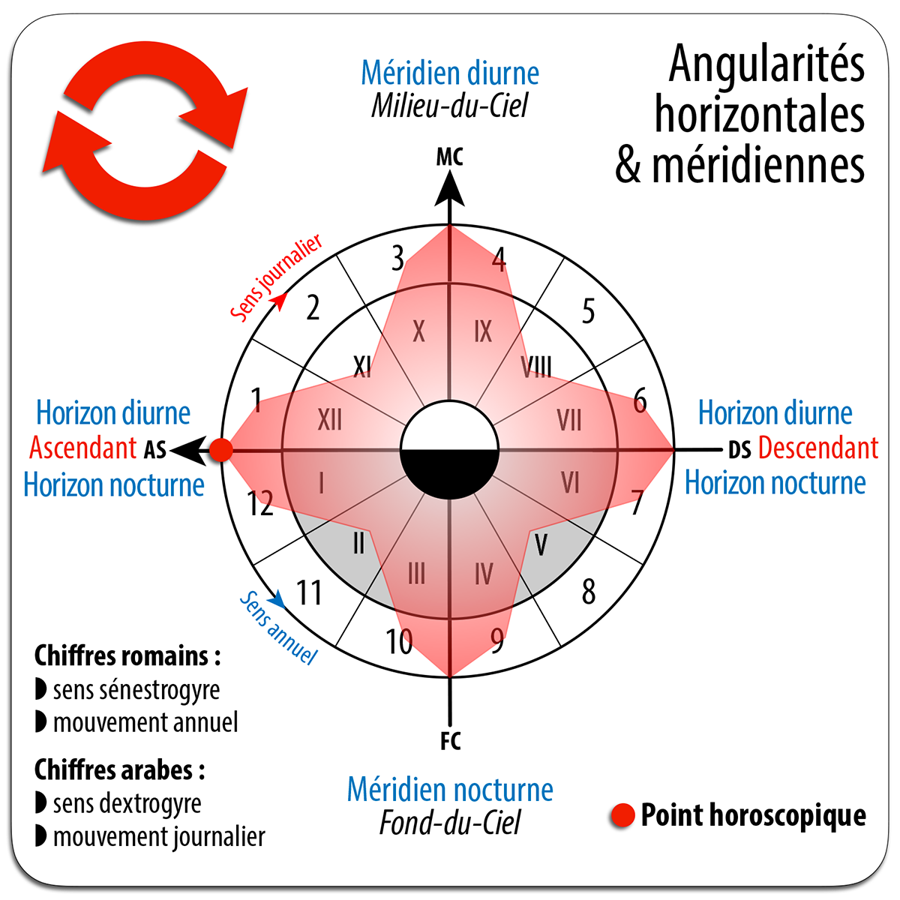
Let us recall to begin with that the word “horoscope” means in Greek “who watches the time”. The horoscopic point defines the zodiacal degree, calculated in ecliptic longitude, that rises on the eastern horizon for a given hour. It is only by an abuse of language that the word “horoscope” has become a synonym for “Natal chart”.
Let’s take a closer look at the horoscopic point, which can be defined as the relative center of the “ascending zone” straddling Houses I & XII, and see how astrologers before Ptolemy proceeded to try to assess the particular effect that they believe occurs when a Planet is nearby. The oldest Chaldean texts refer above all to the criterion of its visibility. The ascending Planet is therefore then obviously above the horizon, that is to say in House XII, and if it is about to rise, therefore still invisible below the horizon, it is located in House I.
Ptolemy’s predecessors then wondered when the ascending Planet was most powerful. Was it at the exact moment of its passage over the horizon, therefore on the horoscopic point or beginning of House I, or indeed after, when it crossed the border separating the nocturnal from the diurnal, that it then changed direction? state and is clearly visible in House XII? Was it also necessary to take into account the duration during which it was still under the horizon, therefore in House I, knowing that then it was gradually changing state by finishing its nocturnal course and preparing to climb above the horizon and begin its daytime course?
These questions were at the origin of debates on what the ancient astrologers called the “center” of the ascending zone. The “center” was defined as the position inside this zone where the planet had the maximum power. It was the subject of various and mostly abstruse calculations that need not be mentioned here. In the controversy over the “centers”, two camps clashed. The first, very much in the minority, was that of the maniacs of absolutist astronomical precision, for whom the “center” could only be the horoscope point. The second — that of the observers of astrological reality — brought together those who believed that the “center” was located somewhere inside House XII.
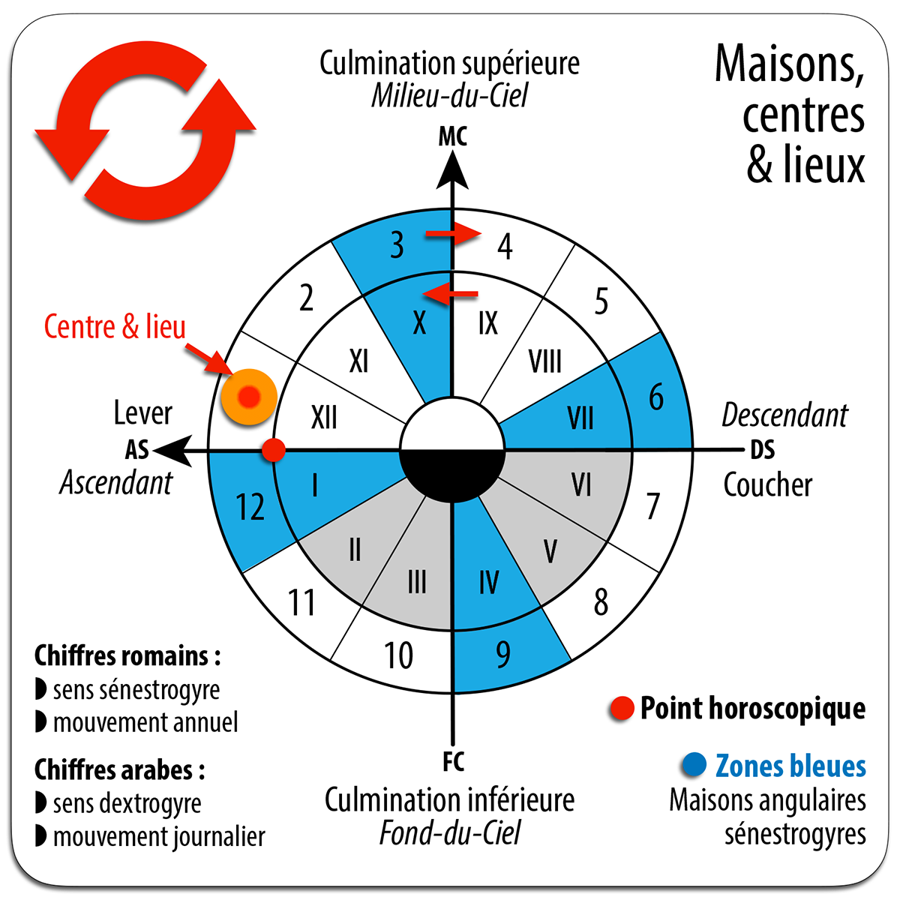
The position of the first camp not lending to discussion, it is to this second camp that we will be interested. His supporters disagreed among themselves on three points. The first point was that of the basis on which the calculation of the “center” had to take place. Some pleaded for a “center” space, that is to say located at a certain number of degrees above the horoscopic point, and others for a “center” temporal, calculated according to the duration of the progression of a Planet above the horizon therefore in House XII. From a purely astronomical point of view, it was the latter who were right. The second point was that of the position of this “center” within House XII, that is, of its greater or lesser proximity to the horoscopic point. Finally, the third point was that of the absolute or relative character of this “center”: if it were absolute, the Planet had to be located exactly on this “center”; if it were relative, this “center” was only the center of an area within which the Planet could be considered as belonging to this “center”. And most supporters of the “relative center” agreed that the extent of it extended to the horoscopic point, therefore in the part of House XII closest to the horizon.
The problem of “center” also affected the understanding that ancient astrologers had of Houses and their boundaries, whatever house system they used. Indeed, for most of them, the “center” and its periphery merged with the “place” where he was. The notion of “place” was significantly different from that of House, in that it designated a section of space or time which could either belong directly to a House or even be confused with it, or be attached to it while being located nearby therefore outside the limits of the latter. The interaction between “places” and Houses has thus led a very large number of astrologers to modify and move the limits of the Houses to integrate the “places” adjacent.
At some undetermined time at the end of the last millennium BC, the ancients decided to classify the Houses in the senestrogyrate direction. Thus the 12 Houses were divided into three groups: the angular, succeeding and cadent Houses.
▶ Angular houses (I, X, VII & IV) adjacent to the horizontal plane (I & VII) or to the meridian plane (X & IV). The Planets located there were considered to have the strongest and most determining influence;
▶ Succeeding houses (II, V, VIII & IX) located equidistant from the horizontal and meridian planes. The Planets located there were considered to have less influence than the preceding ones;
▶ Cadent houses (III, VI, IX & XII), they are also adjacent to the horizontal plane (VI & XII) or to the meridian plane (III & IX). The Planets located there were considered to have the weakest and least determining influence.
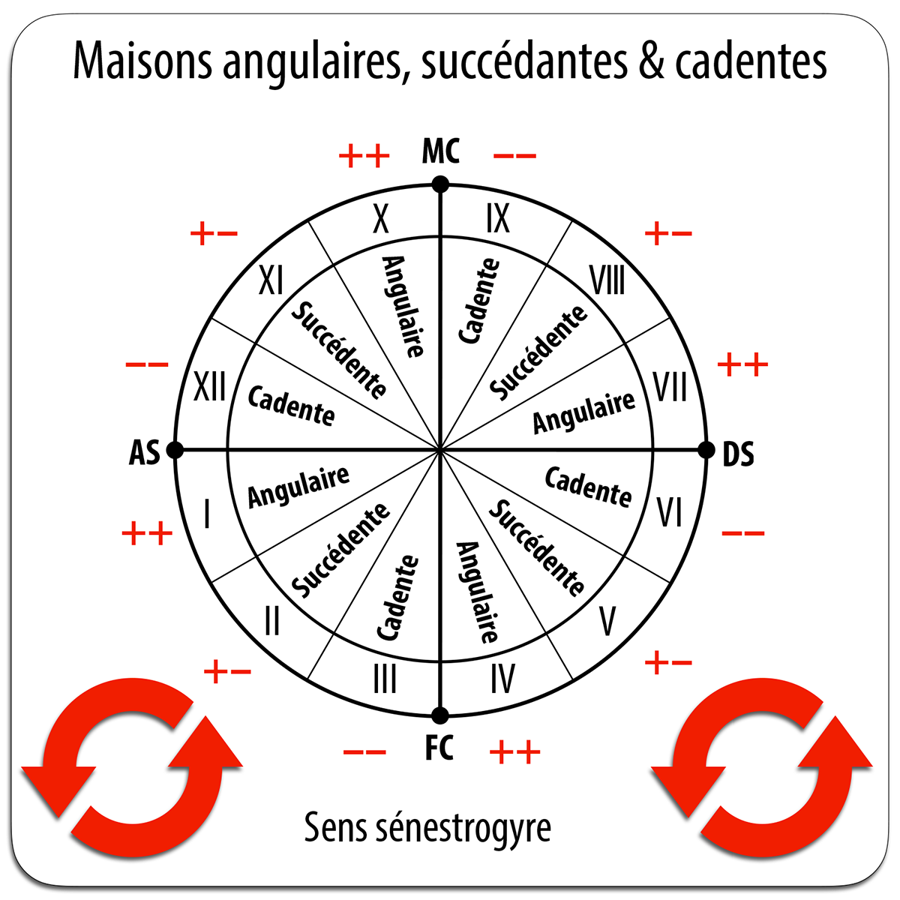
This logical classification on the criterion of relative influence (“++” for angulars, “+–” for succeedings and “––” for cadents) poses a boundary problem. Indeed in this system, angular and cadent houses are contiguous. This implies that by crossing the horizontal or meridian border which separates them, a Planet passes without transition from a “++” status to a “––” status in the sinestrogyral direction and from a “––” status to a “++” status in the dextrogyrate direction. However, whether they were senestrogyrists or dextrogyrists in their conception of the succession of the Houses, in general the astrologers agreed that this sudden passage from strong to weak or vice versa did not correspond to what could be observed in the zone of the ecliptic concerned.
Indeed, the observational data showed that the zones of maximum or minimum influence of the Planets were not delimited by the borders between Angular and succeeding Houses, but overlapped these. To solve this problem and thus make theory and practice coincide, two solutions were necessary for astrologers confronted with this problem:
▶ or they kept their relevance to the Houses as factors in the hierarchy of planetary powers, and in this case they had to shift their limits. This involved freeing oneself from the exactness of their borders determined by astronomical calculations;
▶ or they agreed that the Houses were not adequate operators to determine the hierarchy of the planetary powers, and in this case it was necessary to replace them with another system of division of the local sphere (this is what the Gauquelins did in defining their “sectors”). This system would be superimposed on that of the Houses and would not respect its boundaries. It would be made up of two types of zones: those overlapping the angular and cadent Houses on the one hand, and those overlapping the succeeding Houses on the other. The first (zones of angularity) classified as “++” would delimit the extent within which the most influential Planets are located, and the second “––” (zones of non-angularity) the extent outside inside which the less influential Planets are located. Between these two large zones could be inserted intermediate zones classified “+–” or “–+” which would contain the Planets of intermediate influence.
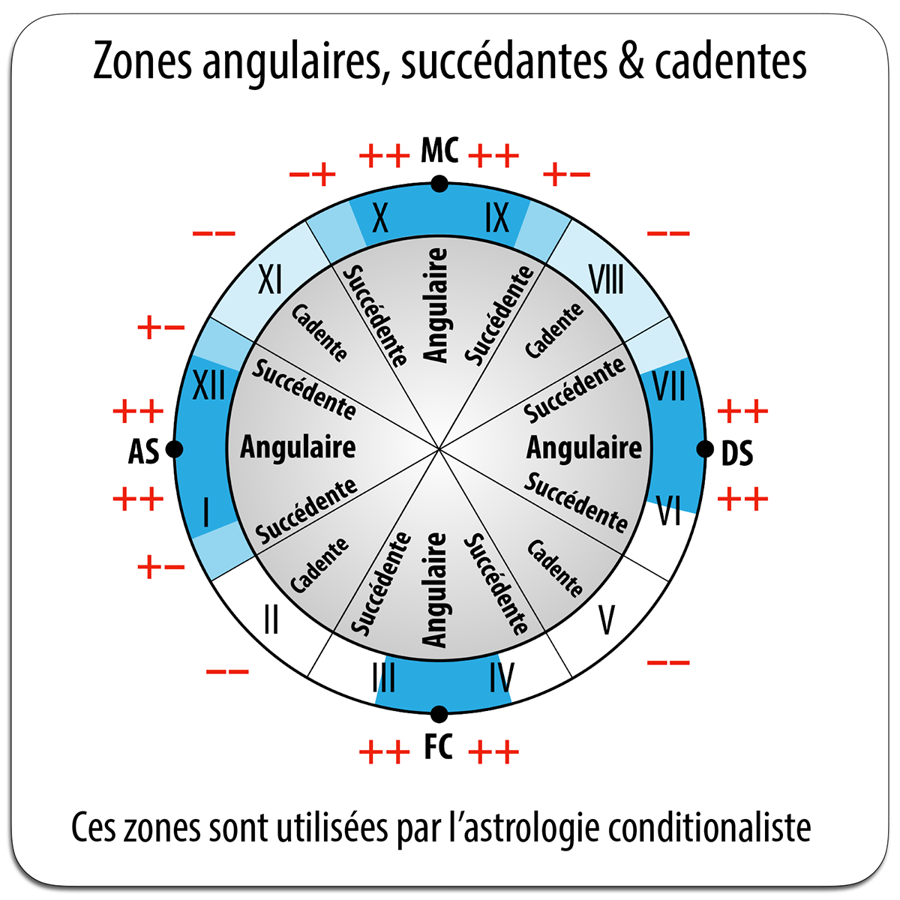
The second solution was the most logical and the most consistent with observational data. Unfortunately, it is not this one that has had the preference of the majority of astrologers. It is even possible, if not probable, that they did not even imagine it, as it seemed obvious to them that the Houses were the only possible divisions of the local sphere. On the other hand, some of the most daring proposed a third-party solution allowing the Houses to be kept as hierarchical operators. This solution consisted in shifting all the Houses by 15° or an equivalent time fraction in the dextrogyrate direction. In this system, the limits of Houses I, XII, VII & VI were located on either side of the horizon and those of Houses X, IX, IV & III on either side of the meridian.
The audacious supporters of this second solution — which was nevertheless the best — were in the minority and it was therefore the first, more conservative, which prevailed and which has been perpetuated over the centuries.
Those who have chosen this solution conservative were therefore forced to significantly modify the boundaries of the Houses in order to match theory and practice. These modifications also had to be respectful of the laws of the geometry of the local sphere. This was represented by a circle whose division into twelve equal parts in space or time could only give each House an area of 360°/12 = 30°. For example, shifting the beginning of House I by 5° and therefore making it start at 25° from House XII in the senestrogyrate direction implied performing a uniform rotation of 5° in all the Houses. Moreover, this decoupling of the horoscope point and the beginning of House I appeared to these conservatives as a kind of sacrilege.
This is most likely the reason why they wondered how far they were allowed not to go too far in this boundary reform. It is a constant in the long history of conservatives in all areas who are forced by reality to carry out moderate reforms. The most daring among these timorous proposed to go up to an offset of 10° of space or 1/6 of time according to the house systems to which they referred. The maximum range of “places” where were the “centers” planetary powers thus found themselves included in these largely shifted Houses, and from their point of view the problem of the adequacy between theory and observation was thus resolved.
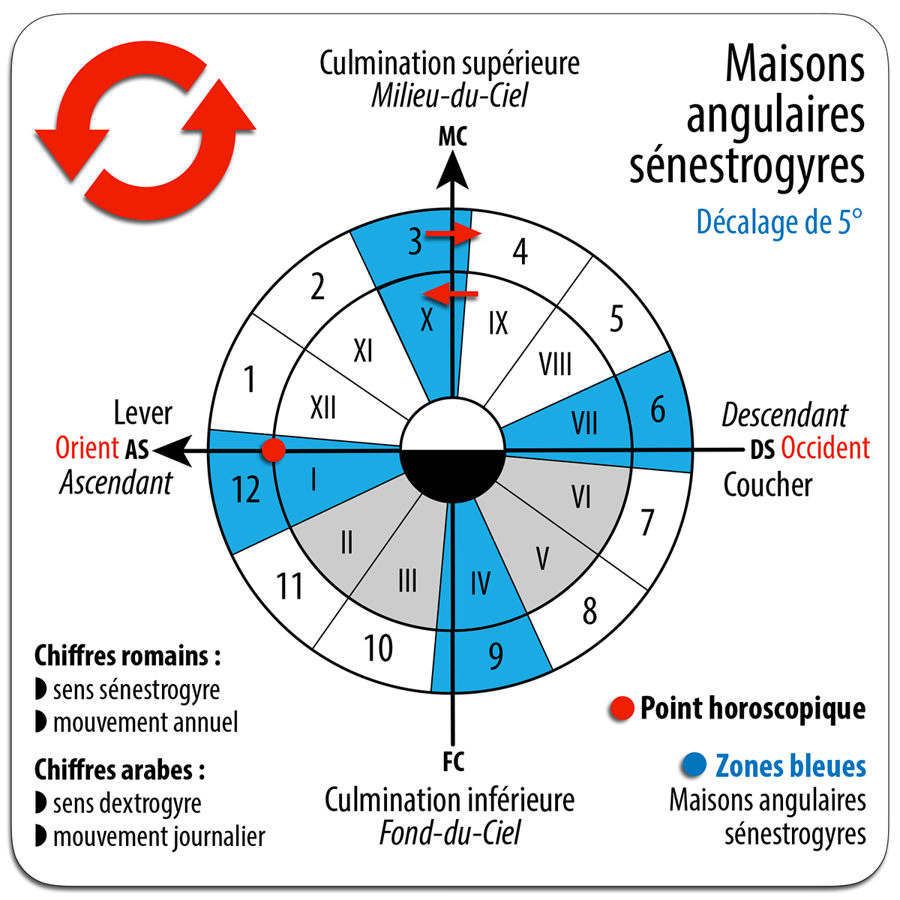
But the most conservative, who were also the least observant, felt that this 10° shift was a very exaggerated reformer accommodation, to which they preferred the 5° shift. As they were the most numerous, their opinion prevailed and gradually became the standard that prevailed, and it was accepted by the majority that the beginnings of Houses were now shifted by 5° in the dextrogyrate direction. Therefore, the question of “places” and their “centers” gradually disappeared, and with it any theoretical possibility of amending this bastard system, half goat half cabbage, which departed from the orthodoxy of the design of the Houses without being as coherent as possible with the observation data.
We do not know when the senestrogyrists took a… major and lasting ascendancy (sic!) over the dextrogyrists. Let us recall that the first were partisans of the system of Houses which orders their succession in the opposite direction of the needles of a clock (direction AS-IC-DS-MC) and thus of the observable movement of the Planets around the horizon, whereas the seconds argued in favor of the reverse order of succession (meaning AS-MC-DS-IC) in accordance with the daily planetary rotations observed. Indeed, the period documents reporting on these problems are few, imprecise, fragmentary, scattered, and of a dating at best very imprecise, at worst non-existent. The reconstruction of these debates and controversies between specialists therefore remains speculative.
What seems proven by the retrospective analysis is that the dextrogyrists seem to have been absent from the debates which opposed the supporters and opponents of the 5° or 10° shift. This means that the senestrogyrist position had probably become hegemonic when these controversies took place.
One can wonder about the reasons for this absence. The dextrogyrists were however also concerned by this problem which invited them to operate the same rotation of 5° or 10°, but for them in the other direction. By doing so, they would have been led, for example, to grant greater influence to their House XII (the I of the senestrogyrists) located just below the horoscopic point on the eastern horizon. But one can think that they were better observers, since for them there was no doubt that the Planets rising above the horizon were very influential, in principle in all the extent of what was for them the House I (the XII of senestrogyrists), which has been clearly confirmed by statistics two millennia later. This quality of better observers could have encouraged them to grant a strong influence to the Planets about to rise, therefore in their House XII (the I of the senestrogyrists). It is also possible that as faithful heirs to the Chaldean tradition, they did not ask themselves this kind of question, since the known Babylonian documents do not mention any system of Houses. These are only retrospective deductions and pure conjectures. In truth, we will never know for sure what really happened.
We also know nothing about the position of the dextrogyrists regarding the system of self-centered Houses. Remember that the supporters of this system were the most strongly reformers, since for them it was nothing less than a radical redefinition of the positioning of the Houses. In their view, the Houses were no longer defined by their limits, but by their center. The horizontal horoscopic point was thus no longer the beginning of House I (or of House XII for senestrogyrists), but became its center. It goes without saying that the limits of all the other Houses were also shifted by 15°. To take only the case of the Houses “angular”, House I thus found itself straddling the eastern horizon, House X straddling the upper meridian, House VII straddling the western horizon and House IV straddling the lower meridian.
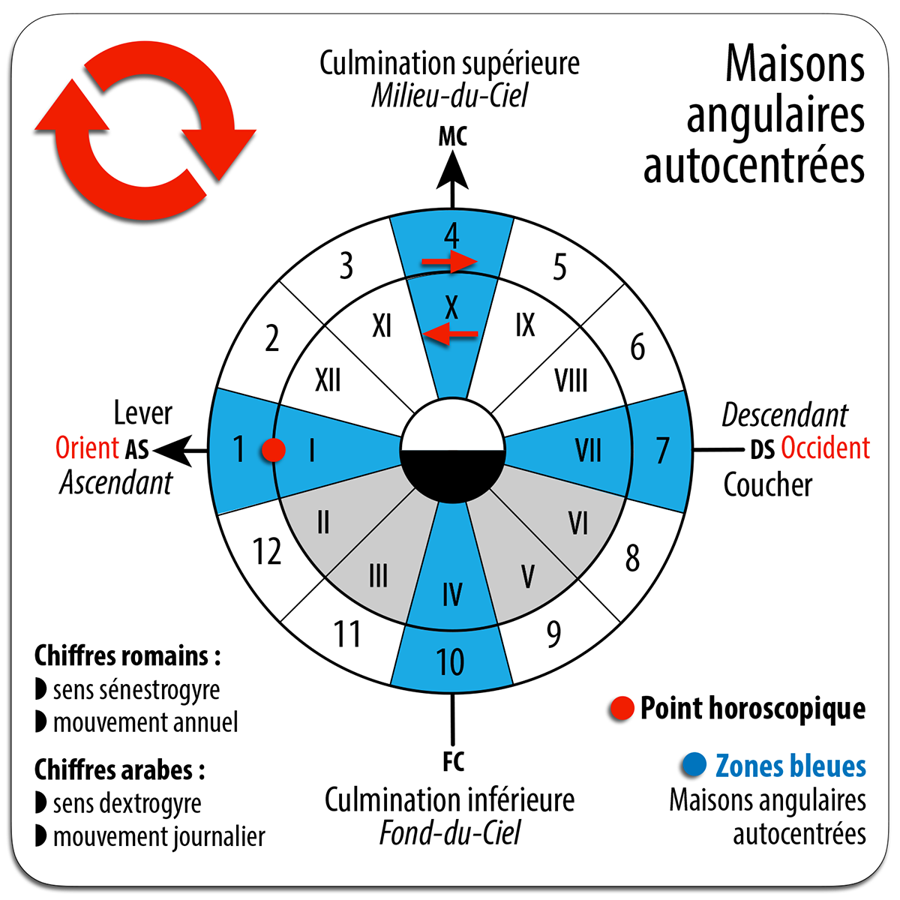
The resemblance of these ancient self-centered houses with the “key sectors” of the Gauquelin statistics produced from computerized studies in 1984 is very striking:
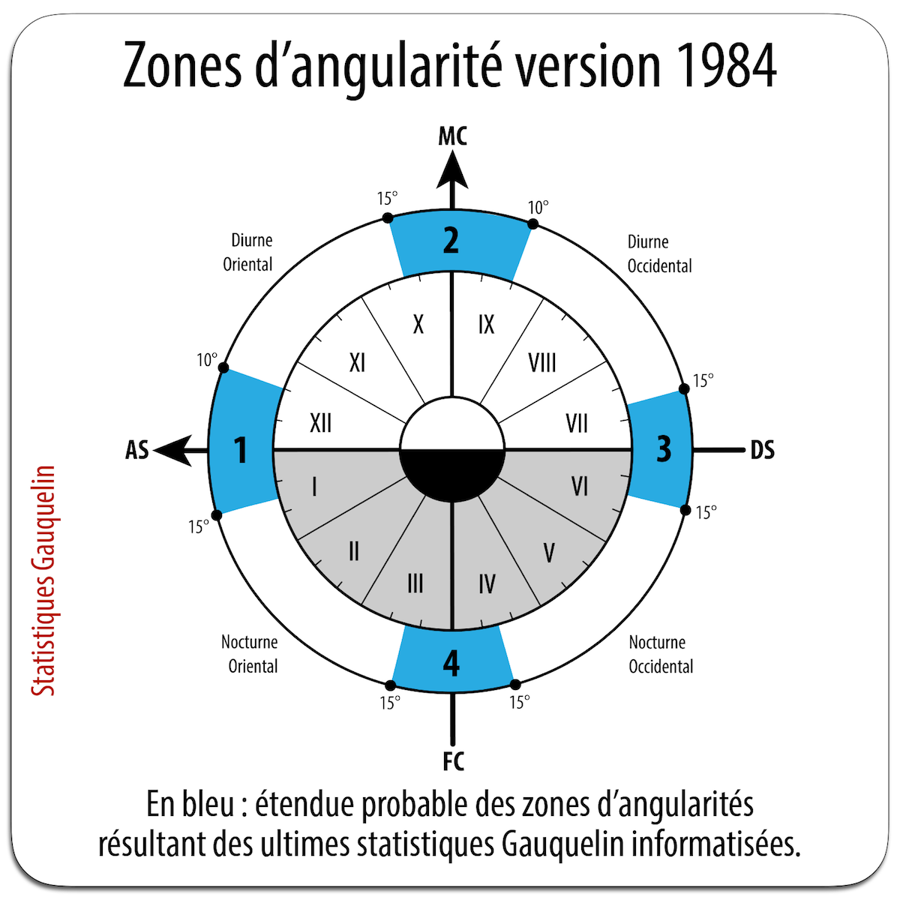
This radical solution made it possible to put an end to the old problem of “centers” and “places” outside the Houses where they should have been so that theory and practice correspond. In effect, “centers” and “places” were now contained within these central Houses, and therefore merged with them. The debates no longer focused on their positioning. The only question that arose was whether the “center” of planetary power was confused with that of the central House I, or if it was eccentric above or below the horizon. In the first case, a Planet was at its maximum power when it was exactly located on the horizon. In the second case, the eccentricity above the horizon was probably the most commonly accepted solution, since it was precisely this planetary position which was at the origin of the redefinition of the Houses by their center. It is nevertheless probable that the less bold pleaded for a “center” below the horizon, so as not to cut yourself off too much from the old definition of the senestrogyrate I House.
As already explained, this dextrogyrate rotation of 15° made it possible to determine 4 major Houses centered respectively around the ascendant (AS), the upper meridian (MC), the descendant (DS) and the lower meridian (IC). It also made it possible to maintain the distinction between angular, succeeding and cadent Houses, but by upsetting the order of succession, in effect:
▶ the angular Houses containing the centers AS, MC, DS and IC had the greatest influence “++” for the determination of the dominant Planets; the succeeding Houses became in this system those which were contiguous to the preceding ones and had a lesser “+–” or “–+” influence and therefore conferred on the Planets which were there a lesser relative power;
▶ the cadent Houses found themselves contiguous to the preceding ones, therefore had a weaker “––” influence than them, and conferred on the Planets that they contained the weakest relative power, making them non-dominant.
This system would have been very logical and would have accounted for observational data very well, but it was not dreamed up by the astrologers of that time or even developed, as has just been done, by its minority supporters. The reason for this abandonment may lie in the fact that it appeared too heretical compared to a conservative conception of the Houses, which had already become more or less “traditional” and therefore very difficult to question so radically. This is very unfortunate, given that this system of self-centered Houses was the only one that could have brought dextrogyrists and senestrogyrists into agreement, at least on one essential point.
The diagram below represents the compared angularity zones of the three systems. Its four-pointed star shape with perfect and ideal symmetry is a stylized representation of the planetary angularity zones whose statistics made it possible to reveal the imperfect but real experimental profile. The orange star represents the zones of senestrogyrist angularities according to “traditional” astrology, blue the areas common to pre-Ptolemaic dextrogyrist astrologers and Gauquelin statistics, and red the ideal areas determined the horizontal and meridian axes. The real zone of the observed planetary dominants is between the red star and the blue one.
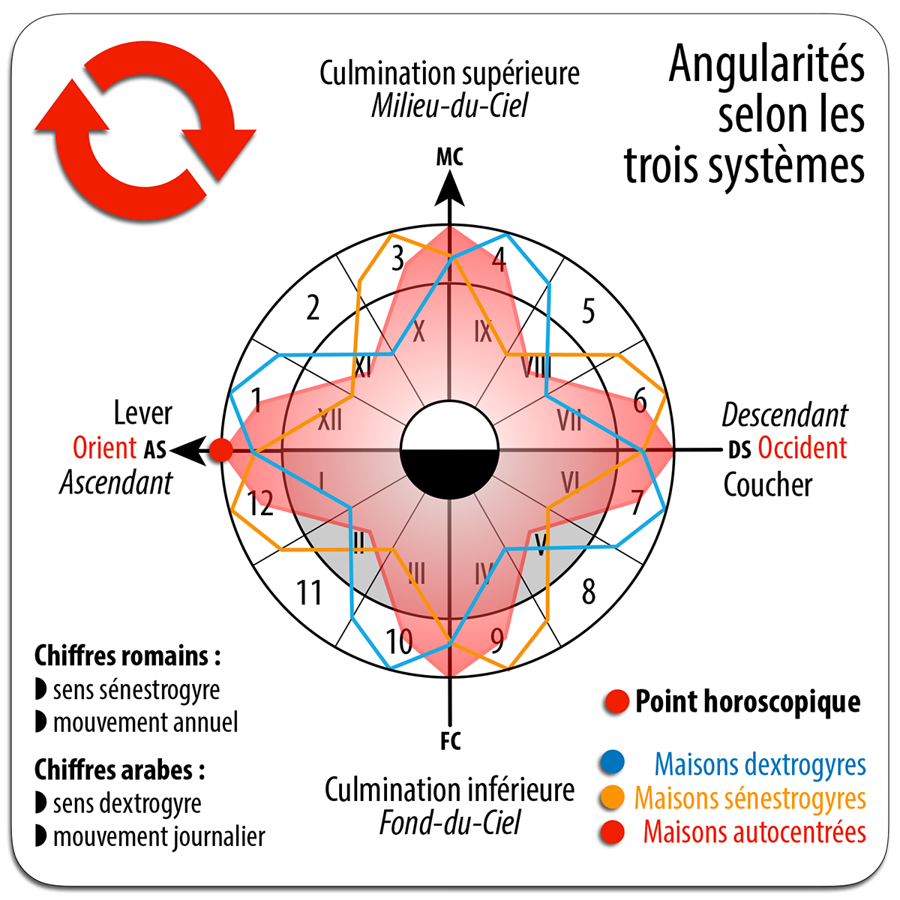
At 2nd century, Ptolemy sets out in his Tetrabiblos the astrological theories and practices of his predecessors. He makes only a brief reference to the senestrogyrate system of numbering the Houses, which he validates without dwelling on it, and no allusion to the dextrogyrate system and the self-centered Houses. While he is nevertheless not stingy with rationalizing explanations, if not always rational, and he very frequently refers to astronomy to legitimize astrological theories and practices, he does not consider it useful or necessary to explain why he made this exclusive choice. A choice which had the consequence of making believe, given the enormous influence of his work which was for centuries a major reference, that the senestrogyrate reference was the only one, whereas it is a historical and epistemological untruth.

We are going to see that this choice of senestrogyrate houses had considerable consequences on the determination of the planetary powers, which is linked to the presence of the Planets in certain Houses, not because of the meanings attributed to them, but because of their proximity to the horizon and the meridian. We will come back to it.
For the clarity of the presentation that follows and in order to avoid any confusion, we will refer to the senestrogyrate numbering system of the Houses which has become “classic” and “traditional” because he was the one Ptolemy held back and for no other reason.
These controversies which agitated the astrologers of this pre-Ptolemaic period may appear derisory, irrational and Byzantine to an outside observer and therefore uninformed of what they reveal and conceal. They were, however, the multiple fruits of a single and essential questioning. It was indeed a matter of nothing less than defining as precisely as possible the limits of the horizontal angularity zones, this definition also geometrically affecting those of the meridian angularity zones. For these ancient astrologers, the problem of the limits of the zones of angularity was confused with that of the borders of the Houses in their astronomical definition and in their astrological meanings. And it is precisely this problem that astro-statisticians like Paul Choisnard, Léon Lasson and the Gauquelins found themselves confronted with two millennia later.
Ptolemy does not mention these controversies in his Tetrabiblos, which will become from 2nd century the reference work for generations of astrologers. However, it is quite unlikely that he was unaware of its existence. We will not dwell here on the reasons for this absence: they would only be vain conjectures. We will content ourselves with retaining his objective position: he opted for senestrogyrate Houses whose limits he shifted 5° in the dextrogyrate direction above the horizon like others before him. This means that for him, House I has an extent of 30° which starts at 25° of House XII and ends at 25° of House I, all the other Houses being affected by this shift. It follows that he considers a Planet ascending on the horizon as dominant only within this expanse.
However Ptolemy is thus confronted with a big logical problem. Indeed, he generally considers that the planetary effects are reinforced above the horizon, and diminished below, which was indeed confirmed 20 centuries later by statistical studies. But at the same time he considers that House I, under the horizon for his 5/6 as he defines it, is after House X located before the upper meridian, the second in importance for judging planetary powers according to their positions in the Houses “angular”.
He therefore finds himself faced with a aporia. Indeed, either the general rule that he himself enacts is that the Planets are more powerful above the horizon, and in this case he is obliged to recognize that this rule only applies to the ascending Planets located in the 1/6 of House I overflowing on House XII, which it does not do; or he considers that the mostly nocturnal status of House I is an exception that confirms the general rule. This is what he does, and to justify this choice, he pitifully summons a pseudo-physical argument ad hoc. This irrational argument is as follows: the planets ascending in House I, therefore below the horizon, would be more powerful than those ascending in House XII because the mists and vapors above the horizon would weaken them by obscuring their effects.
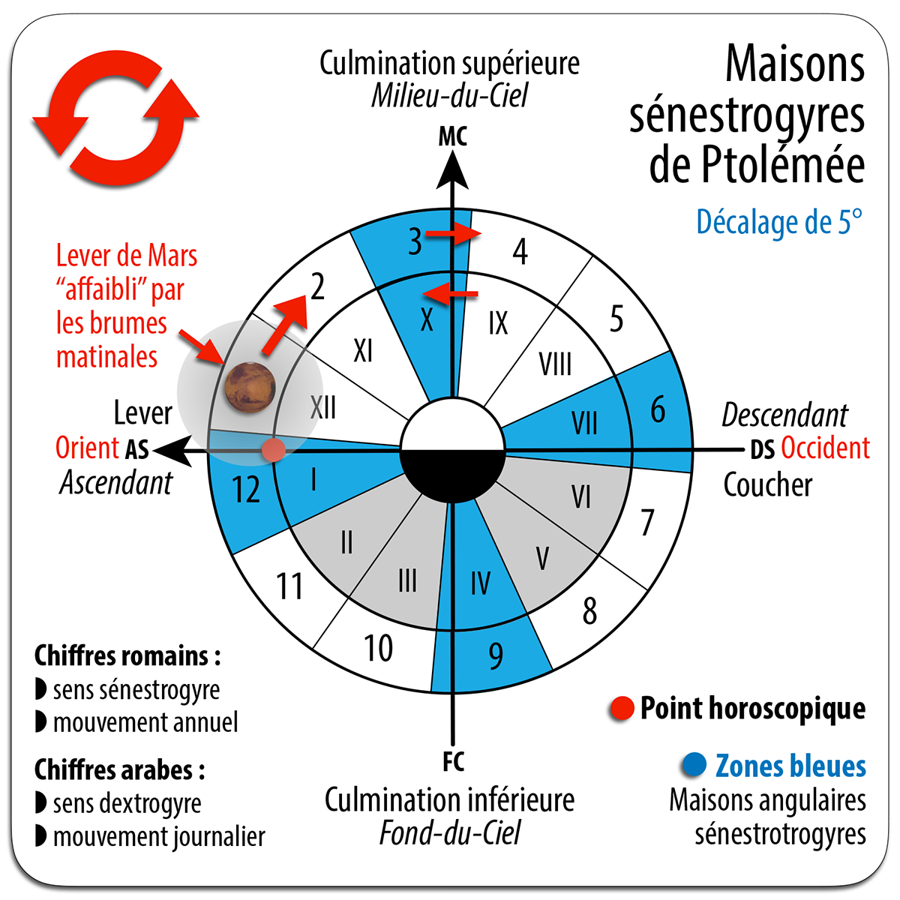
It is bullshit. The problem here is not that of the physical relevance of the argument in itself, since the ancients admitted without problem that terrestrial vapors could rise to the stars and affect their properties. The problem is that this planetary weakening due to terrestrial vapors should logically also apply to 1/6 of the House I located above the horizon, and even especially to this one since it is the closest to these misty exhalations. Moreover, if we summon the morning mists to explain this exception to the rule, we can do the same for the evening mists, which would then affect all the Planets located in House VII, too “angular” but which is above the western horizon.
Ptolemy’s pseudo-physical argument is therefore worthless. But admitting it would ruin the shift ad hoc of 5° carried out to account at least for the power attributed to the Planets which have just risen and are therefore no longer below the horizon… Faced with this irresolvable aporia, Ptolemy admits nothing. He pursues his reasonings without worrying about this flagrant contradiction within the system he defends. And it is undoubtedly because of this aporia that he decided to make House X adjoining the upper meridian the main House “angular”: the middle of the day by definition does not pose any problem of morning or evening vapours…
This position defended by this irrational argument undoubtedly designates Ptolemy as either a pure theoretician reluctantly making a slight hitch in astronomical orthodoxy in the definition of the limits of the Houses, or a very episodic practitioner coupled with a very poor observer, the two excesses or deficiencies can of course be combined.
On reading the Tetrabiblos, there is little doubt about it. It is therefore not impossible that he perceived the controversies of his predecessors as irrational and vulgar debates of low-level practitioners without theoretical rigor. He was seriously mistaken and dragged his successors in his wake who took this error at face value. Ptolemy’s error has become the doxa astrologers. It is even worse than that: from the rich, complex and contradictory teachings of Ptolemy’s work, those who made it their bible have for the most part retained only this error. Worse still, in their hierarchy of Houses “angular”, they put the House I before the X for the sole reason that it contains the horoscopic point.
Here is what Ptolemy wrote on this subject: “We evaluate the power of the planets, in the first place, from two considerations: either they are oriental and increase their own movement — because they are then very powerful — or they are western and decrease their movement — because then they have a more energy. weak. Secondly, from their position in relation to the horizon, because when they are in the Midheaven or immediately following it, they are particularly powerful. They have less strength, on the other hand, when they are exactly on the horizon or immediately following it. Their power is greater each time they are on the eastern horizon, and less each time they culminate under the Earth or are in another configuration with the rising place (the Ascendant). But, if not, their power is nil” (Claudius Ptolemy, The Unique Book of Astrology or Tetrabible, Book I, chap. 24).
This text deserves to be analyzed in detail, because it alone sums up all the absurdity of the system of senestrogyrate Houses when it is combined with the daily dextrogyrate rotation of the Planets around the horizon.
Indeed Ptolemy asserts both that the eastern planets are more powerful than the western ones and that those on their diurnal arc (above the horizon) are more powerful than those on their night arc (below the horizon). It should logically follow that the planets in the diurnal eastern quadrant (from rising to upper culmination, Houses XII, XI & X) are the most powerful. However, only the planets in House X and those located in the last 1/6 of House XII are however considered as such by the same Ptolemy, while the Planets in House XII are also in their increasing diurnal movement and located on the western horizon. If it were logical within its own system, it should consider that the Planets in House VII, therefore diurnal, have a higher power than those in House I, therefore nocturnal. But this is not the case: Ptolemy affirms on the contrary that the Planets in House VII have a lesser power than those in House I. Finally he affirms that the Planets outside Houses X, I & VII have a “zero power”, even though House IV adjacent to the lower meridian is “angular”, therefore considered by itself as having a valuing power on the Planets which are there.
Finally, the system of senestrogyrate Houses that he adopted and even amended forced him to make a description of the daily movement opposed to the reality of the observable rotation of the Planets around the horizon. Indeed, this system obliges him to write that a Planet in House X immediately follows its passage to the higher meridian, whereas what happens is exactly the opposite: in the reality of the local sphere which is that of the dextrogyrate movement, a Planet in House X is located in the phase which immediately precedes its higher culmination, and not which follows it. If Ptolemy had adopted the much more realistic dextrogyrate system that many of his predecessors advocated, he would have avoided this kind of blatant contradiction.
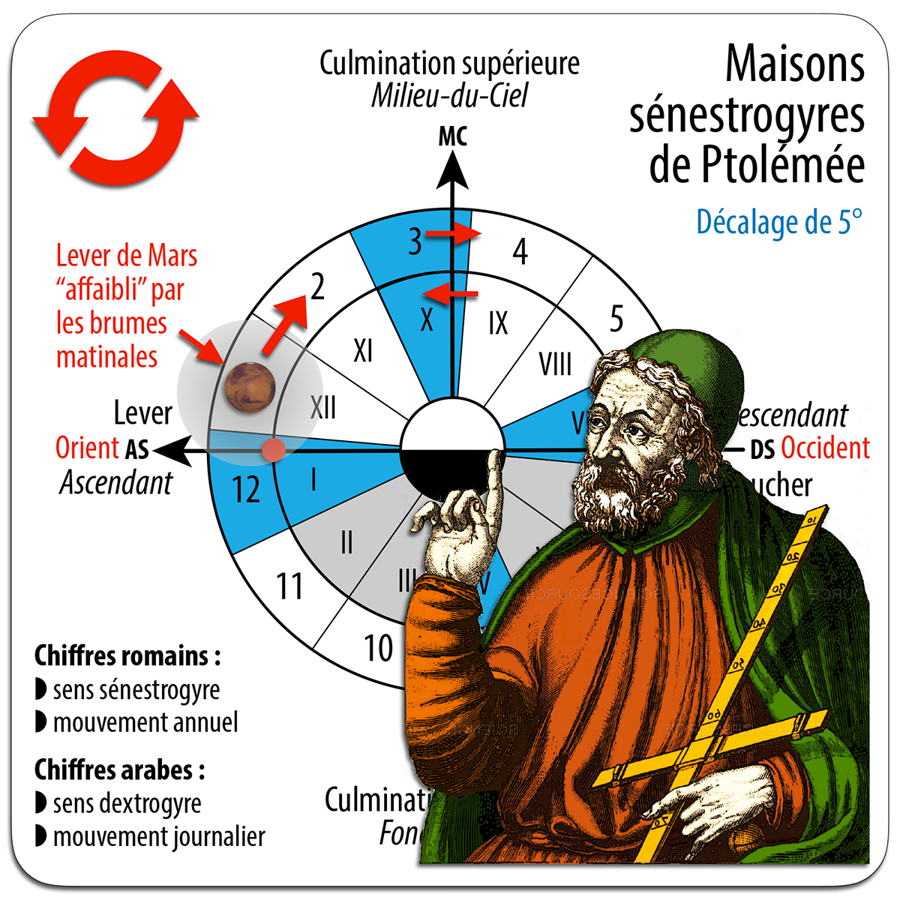
Continuation and end: the followers and followers of Ptolemy made the shift of 5° of the limits of the senestrogyrate Houses endorsed — and instituted, given his authority in the matter — an untouchable dogma. According to this dogma, any Planet located above the horizon in House XII at more than 5° from the cusp of House I or horoscopic point is considered as “very weak”. It is the same for example for a Planet in House X: it is considered as angular and therefore dominant only if it is located in a zone between the first 5/6 of this House and the last 1/6 of House IX if we count in the dextrogyrate direction. Since the rediscovery of Tetrabiblos in the Middle Ages, we find this dogma in all astrological texts, with a few very rare exceptions. It will only be shaken, let us remember, by the first astro-statistics of the 20th century.
It very probably existed during the last 3 or 4 centuries practicing astrologers, whether they were simple objective and critical observers, or even having had access to pre-Ptolemaic archival documents, who questioned this dogma by confronting it with their experience as interpreters and/or with other traditional texts. They could realize live only Planets located in Houses XII, IX, VI & III, judged “very weak” according to the tradition relayed by Ptolemy, were in fact “very strong” in the functioning of individuals whose Natal Chart included this kind of characteristic. But if they did exist, they left no known written records.
Their hypothetical existence may certainly seem like pure conjecture that can probably never be confirmed. To be objective, I must admit that this conjecture is based on my personal experience as a practicing astrologer. Indeed, when I began the study and practice of this knowledge, for a few years I could only base myself on the manuals that could be found in bookstores. And all of them, without exception, repeated the Ptolemaic dogma of planetary angularities (I specify that in addition I had not read the Tetrabiblos at that time). I therefore applied it to interpret a large number of sky maps of my family members, close friends and more distant acquaintances. And in many cases, I noticed that Planets considered as “very weak” in application of this dogma appeared as “very strong” in what I could observe of the functioning of these people.
But I initially doubted my own observations, putting them down to my inexperience as a beginner, which did not allow me to question the teachings of astrologers who wrote textbooks, which I imagined at the time when they were much more knowledgeable and experienced than me. It was only when I discovered the existence of the statistical work of the Gauquelins that I allowed myself to think that my observations were perhaps really based on objective facts. I am therefore justified in thinking that many other astrologers were able to make the same observations as mine, and adapt the Ptolemaic dogma to their practice. This is a perfectly realistic and reasonable guess.
One of the major contributions of the Gauquelin statistics was therefore, without them knowing or especially wanting it, on the one hand to give partial reason to the supporters of the system of dextrogyrate Houses and therefore to the planetary valuations observed by the Chaldeans and many pre-Ptolemaic Greek astrologers, and on the other hand to give partial reason to the partisans of the self-centered Houses, to which the “key sectors” Gauquelin resemble very strongly in their scopes. In doing so, the Gauquelin studies thus objectively rehabilitated the positions of the most observant pre-Ptolemaic astrologers and made it possible to correct Ptolemy’s fundamental error. It is of course impossible to see this if one does not know the history of astrological conceptions.
It is true that the Gauquelins did not work to obtain such a result. They have always been convinced that their statistics have in this matter ruined a basic postulate of astrology in general. While in fact, they had only partially invalidated the erroneous choice of the dextrogyric Houses of Ptolemy, which over the centuries had become the doxa traditionalist astrologers in the writings from which they drew their illusions of knowledge. This is a special case of serendipity paraxoxal, serendipity being the fact of finding something other than what one was looking for and the paradoxical character residing in the fact that the Gauquelins did not even realize that they had discovered something other than what they thought they had found.
Dijon, 14th June 2019.
▶ The specific issues of astrological statistics
▶ Tests et prétextes : comment démonter l’astrologie ?
▶ Astrologie canine, astrologie cynique ? À propos d’une expérience statistique sur des chiens
▶ Carlson’s “experiment”: an example of anti-astrologist quackery
▶ The Petiot affair and the “Barnum effect” or the anti-astrologer circus
▶ Le problème des jumeaux en astrologie
▶ Uranus astronomique
▶ Sun-Uranus aspect
▶ Mars-Saturn aspect
▶ Astrologie et astrologies : écoles, courants et chapelles
▶ Results of conditionalist astrology
▶ Results of traditional astrology
▶ Results of statistical astrology
▶ The world according to Claudius Ptolemy, astronomer-astrologer and lighthouse of Alexandria
▶ Ptolemy and the error of the senestrogyrate Houses
▶ Introduction to the comparative results of astrologies
▶ Anar-show en hommage à Paul Feyerabend
▶ Ike Uncyfar and Astro-statistics on video
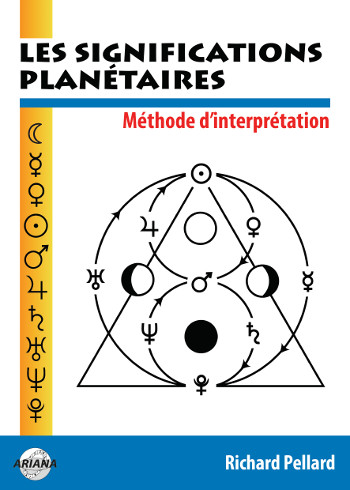
Les significations planétaires
par
620 pages. Illustrations en couleur.
La décision de ne traiter dans ce livre que des significations planétaires ne repose pas sur une sous-estimation du rôle des Signes du zodiaque et des Maisons. Le traditionnel trio Planètes-Zodiaque-Maisons est en effet l’expression d’une structure qui classe ces trois plans selon leur ordre de préséance et dans ce triptyque hiérarchisé, les Planètes occupent le premier rang.
La première partie de ce livre rassemble donc, sous une forme abondamment illustrée de schémas pédagogiques et tableaux explicatifs, une édition originale revue, augmentée et actualisée des textes consacrés aux significations planétaires telles qu’elles ont été définies par l’astrologie conditionaliste et une présentation détaillée des méthodes de hiérarchisation planétaire et d’interprétation accompagnées de nombreux exemples concrets illustrés par des Thèmes de célébrités.
La deuxième partie est consacrée, d’une part à une présentation critique des fondements traditionnels des significations planétaires, d’autre part à une présentation des rapports entre signaux et symboles, astrologie et psychologie. Enfin, la troisième partie présente brièvement les racines astrométriques des significations planétaires… et propose une voie de sortie de l’astrologie pour accéder à une plus vaste dimension noologique et spirituelle qui la prolonge et la contient.
Téléchargez-le dès maintenant dans notre boutique
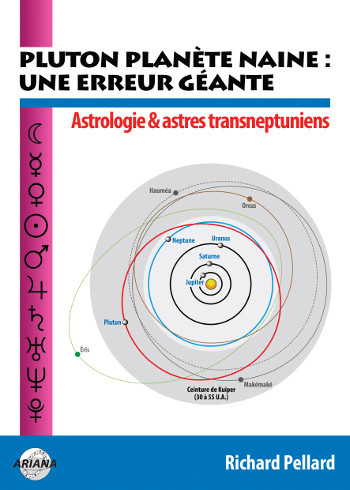
Pluton planète naine : une erreur géante
par
117 pages. Illustrations en couleur.
Pluton ne fait plus partie des planètes majeures de notre système solaire : telle est la décision prise par une infime minorité d’astronomes lors de l’Assemblée Générale de l’Union Astronomique Internationale qui s’est tenue à Prague en août 2006. Elle est reléguée au rang de “planète naine”, au même titre que les nombreux astres découverts au-delà de son orbite.
Ce livre récapitule et analyse en détail le pourquoi et le comment de cette incroyable et irrationnelle décision contestée par de très nombreux astronomes de premier plan. Quelles sont les effets de cette “nanification” de Pluton sur son statut astrologique ? Faut-il remettre en question son influence et ses significations astro-psychologiques qui semblaient avérées depuis sa découverte en 1930 ? Les “plutoniens” ont-ils cessé d’exister depuis cette décision charlatanesque ? Ce livre pose également le problème des astres transplutoniens nouvellement découverts. Quel statut astrologique et quelles influences et significations précises leur accorder ?
Enfin, cet ouvrage propose une vision unitaire du système solaire qui démontre, chiffes et arguments rationnels à l’appui, que Pluton en est toujours un élément essentiel, ce qui est loin d’être le cas pour les autres astres au-delà de son orbite. Après avoir lu ce livre, vous saurez quoi répondre à ceux qui pensent avoir trouvé, avec l’exclusion de Pluton du cortège planétaire traditionnel, un nouvel argument contre l’astrologie !
Téléchargez-le dès maintenant dans notre boutique